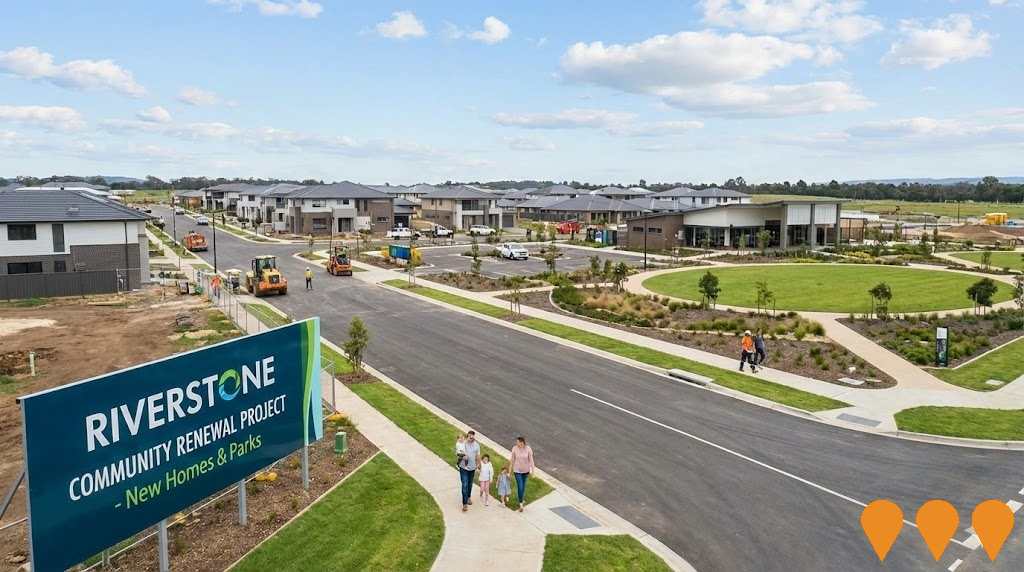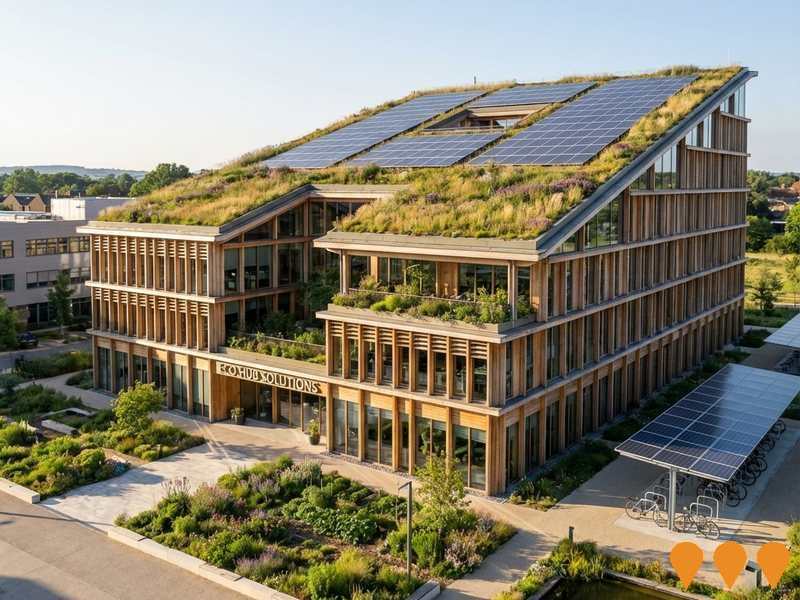Chart Color Schemes
est. as @ -- *
ABS ERP | -- people | --
2021 Census | -- people
Sales Activity
Curious about local property values? Filter the chart to assess the volume and appreciation (including resales) trends and regional comparisons, or scroll to the map below view this information at an individual property level.
Find a Recent Sale
Sales Detail
Population
An assessment of population growth drivers in Tennant Creek reveals an overall ranking slightly below national averages considering recent, and medium term trends
Tennant Creek's population, according to AreaSearch's analysis, is approximately 3,522 as of August 2025. This figure represents an increase of 442 people, a 14.4% rise from the 2021 Census, which recorded a population of 3,080. The change was inferred from the estimated resident population of 3,520 in June 2024 and the addition of one validated new address since the Census date. This results in a density ratio of 83 persons per square kilometer, indicating ample space per person and potential for further development. Tennant Creek's growth rate of 14.4% since the 2021 census surpassed both the national average (8.6%) and the state average, positioning it as a growth leader in the region. Natural growth contributed approximately 57.5% of overall population gains during recent periods.
AreaSearch is utilizing ABS/Geoscience Australia projections for each SA2 area, released in 2024 with a base year of 2022. For areas not covered by this data and to estimate post-2032 growth, AreaSearch applies age cohort-based growth rates provided by the ABS in its latest Greater Capital Region projections (released in 2023, based on 2022 data). Future population trends suggest a below-median increase for Australia's regional areas, with an expected expansion of 392 persons to reach approximately 3,914 by 2041, reflecting an overall increase of 11.1% over the 17-year period.
Frequently Asked Questions - Population
Development
AreaSearch analysis of residential development drivers sees Tennant Creek recording a relatively average level of approval activity when compared to local markets analysed countrywide
Tennant Creek has received around 15 dwelling approvals annually over the past five financial years, totalling 75 homes. As of FY26, there have been 3 approvals recorded so far. On average, 2 people moved to the area each year for every dwelling built between FY21 and FY25, indicating balanced supply and demand conditions. However, this ratio has decreased to 0.4 people per dwelling over the past two financial years, suggesting more balanced supply conditions. The average construction value of development projects is $552,000.
This year, $23.7 million in commercial development approvals have been recorded, reflecting balanced commercial development activity compared to the rest of the NT. Tennant Creek records somewhat elevated construction levels at 15.0% above the regional average per person over the past five years, balancing buyer choice while supporting current property values. Recent construction comprises 58.0% standalone homes and 42.0% medium and high-density housing, with a growing mix of townhouses and apartments providing varied price points from family homes to more affordable compact living. This marks a significant shift from the existing housing pattern, which is currently 81.0% houses, potentially due to diminishing developable land availability and evolving lifestyle preferences.
The location has approximately 175 people per dwelling approval, indicating an expanding market. Population forecasts suggest Tennant Creek will gain 390 residents by 2041. At current development rates, new housing supply should comfortably meet demand, providing good conditions for buyers and potentially supporting growth beyond current population projections.
Frequently Asked Questions - Development
Infrastructure
Tennant Creek has limited levels of nearby infrastructure activity, ranking in the 0thth percentile nationally
Changes to local infrastructure significantly impact an area's performance. AreaSearch has identified four projects likely affecting this region: Venture Housing - Social and Affordable Homes, Tennant Creek Aviation and Accommodation Hub, Territory Energy Link, Urban Public Housing - Peko Road. The following details projects most relevant.
Professional plan users can use the search below to filter and access additional projects.
INFRASTRUCTURE SEARCH
 Denotes AI-based impression for illustrative purposes only, not to be taken as definitive under any circumstances. Please follow links and conduct other investigations from the project's source for actual imagery. Developers and project owners wishing us to use original imagery please Contact Us and we will do so.
Denotes AI-based impression for illustrative purposes only, not to be taken as definitive under any circumstances. Please follow links and conduct other investigations from the project's source for actual imagery. Developers and project owners wishing us to use original imagery please Contact Us and we will do so.
Frequently Asked Questions - Infrastructure
Enabling Digital Health Services for Regional and Remote Australia
National initiative to expand and improve digital health access for people in regional and remote Australia. Focus areas include enabling telehealth and virtual care, upgrading clinical systems and connectivity, supporting secure information exchange, and building workforce capability in digital health, aligned with the Australian Government's Digital Health Blueprint and Action Plan 2023-2033.

Tennant Creek Aviation and Accommodation Hub
ADG has released a draft concept plan for a staged upgrade of Tennant Creek Airport to support regional aviation and logistics growth in the Barkly. The plan proposes extending and strengthening the main runway for regular jet operations, expanding the apron and terminal facilities, modernising electrical systems and signage, and delivering an Essential Key Worker Accommodation Precinct for up to 100 personnel to support government, defence and industry operations.

National EV Charging Network (Highway Fast Charging)
Partnership between the Australian Government and NRMA to deliver a backbone EV fast charging network on national highways. Program funds and co-funds 117 DC fast charging sites at roughly 150 km intervals to connect all capital cities and regional routes, reducing range anxiety and supporting EV uptake.

Network Optimisation Program - Roads
A national program concept focused on improving congestion and reliability on urban road networks by using low-cost operational measures and technology (e.g., signal timing, intersection treatments, incident management) to optimise existing capacity across major city corridors.

Venture Housing - Social and Affordable Homes
A $6.9 million partnership to deliver twelve 2-bedroom social and affordable homes. The project is designed to provide housing for those in need, including older women at risk of homelessness and Aboriginal people eligible for social housing.

Territory Energy Link
A multi-user, multi-asset infrastructure corridor running approximately 670km from near Elliott to the Middle Arm Precinct in Darwin. The 130m wide corridor is planned to support buried services including gas, water, optical fibre, and future hydrogen pipelines, connecting the Beetaloo Sub-basin to Darwin.

Urban Public Housing - Peko Road
A $3.4 million project, part of a larger program to increase public housing supply. The project saw the construction of six new 1-bedroom units for individuals on the Northern Territory's social housing waitlist.

Barkly Regional Deal
A 10-year, $100.5 million partnership between the Australian Government, the Northern Territory Government, and the Barkly Regional Council to improve the productivity and liveability of the Barkly region. The deal includes 28 initiatives covering economic development, social programs, and infrastructure. Wutunugurra is one of the communities benefiting from this deal.

Employment
AreaSearch assessment indicates Tennant Creek faces employment challenges relative to the majority of Australian markets
Tennant Creek has a skilled labor force with well-represented essential services sectors and an unemployment rate of 5.3% as of June 2025. There are 1,842 residents employed, with the unemployment rate being 0.5% lower than the Rest of NT's rate of 5.9%.
Workforce participation is similar to the Rest of NT's 50.7%. The dominant employment sectors among residents include health care & social assistance, public administration & safety, and education & training, with healthcare notably concentrated at 1.4 times the regional average. Agriculture, forestry & fishing is under-represented, comprising only 0.8% of Tennant Creek's workforce compared to 5.0% in Rest of NT. Many residents commute elsewhere for work based on Census working population data.
Between June 2024 and June 2025, the labour force decreased by 1.8%, while employment declined by 1.1%, resulting in a 0.7 percentage point drop in unemployment rate. Jobs and Skills Australia's national employment forecasts from May 2025 project national employment growth of 6.6% over five years and 13.7% over ten years, with local Tennant Creek growth estimated at approximately 7.2%% over five years and 14.9% over ten years based on industry-specific projections.
Frequently Asked Questions - Employment
Income
Income analysis reveals strong economic positioning, with the area outperforming 60% of locations assessed nationally by AreaSearch
Tennant Creek's median taxpayer income was $62,548 and average was $66,374 in financial year 2022. This is higher than the national average, contrasting with Rest of NT's median income of $51,655 and average income of $61,577. Based on Wage Price Index growth of 12.01% since financial year 2022, estimated incomes as of September 2025 would be approximately $70,060 (median) and $74,346 (average). According to census data, household income ranks at the 46th percentile ($1,677 weekly), while personal income is at the 23rd percentile. The largest income segment comprises 36.6% earning $1,500 - 2,999 weekly (1,289 residents). After housing costs, residents retain 90.1% of their income.
Frequently Asked Questions - Income
Housing
Tennant Creek is characterized by a predominantly suburban housing profile, with above-average rates of outright home ownership
The dwelling structure in Tennant Creek, as per the latest Census, consisted of 80.6% houses and 19.3% other dwellings (semi-detached, apartments, 'other' dwellings). This compares to Non-Metro NT's 85.0% houses and 15.0% other dwellings. Home ownership in Tennant Creek was at 13.6%, similar to Non-Metro NT, with the rest being mortgaged (14.3%) or rented (72.1%). The median monthly mortgage repayment in the area was $1,114, higher than Non-Metro NT's average of $1,087. The median weekly rent figure was recorded at $180, compared to Non-Metro NT's $135. Nationally, Tennant Creek's mortgage repayments were significantly lower than the Australian average of $1,863, while rents were substantially below the national figure of $375.
Frequently Asked Questions - Housing
Household Composition
Tennant Creek features high concentrations of lone person households and group households, with a lower-than-average median household size
Family households constitute 60.6% of all households, including 23.8% couples with children, 19.6% couples without children, and 14.2% single parent families. Non-family households comprise the remaining 39.4%, with lone person households at 35.1% and group households making up 4.7% of the total. The median household size is 2.7 people, which is smaller than the Rest of NT average of 3.0.
Frequently Asked Questions - Households
Local Schools & Education
Tennant Creek faces educational challenges, with performance metrics placing it in the bottom quartile of areas assessed nationally
Educational qualifications in Tennant Creek trail regional benchmarks, with 20.7% of residents aged 15+ holding university degrees compared to the national average of 30.4%. Bachelor degrees are the most common at 12.7%, followed by postgraduate qualifications (5.3%) and graduate diplomas (2.7%). Vocational credentials are also prominent, with 29.8% of residents aged 15+ holding such qualifications – advanced diplomas account for 9.4% while certificates make up 20.4%. Educational participation is high in Tennant Creek, with 32.0% of residents currently enrolled in formal education.
This includes 14.5% in primary education, 7.6% in secondary education, and 3.7% pursuing tertiary education. Tennant Creek Primary School and Tennant Creek High School serve a total of 488 students in the area. Educational provision follows conventional lines, with one primary institution and one secondary institution serving the town.
Frequently Asked Questions - Education
Schools Detail
Nearby Services & Amenities
Transport
No public transport data available for this catchment area.
Frequently Asked Questions - Transport
Transport Stops Detail
Health
The level of general health in Tennant Creek is notably higher than the national average with prevalence of common health conditions quite low across both younger and older age cohorts
Tennant Creek shows superior health outcomes with low prevalence of common conditions across all ages. Private health cover rate is 52%, slightly higher than the SA2 average (49.1%).
Diabetes and asthma are most prevalent, affecting 8% and 5.1% respectively. 74.4% report no medical ailments, compared to 77.5% in Rest of NT. Residents aged 65+ comprise 10.2%, higher than the NT average (8.3%). Senior health outcomes align with general population's profile.
Frequently Asked Questions - Health
Cultural Diversity
Tennant Creek was found to be more culturally diverse than the vast majority of local markets in Australia, upon assessment of a range of language and cultural background related metrics
Tennant Creek's population showed higher cultural diversity than most local areas, with 16.5% born overseas and 39.8% speaking a language other than English at home. Christianity was the dominant religion, accounting for 49.9%. The 'Other' religious category had a slightly higher representation in Tennant Creek (1.9%) compared to the Rest of NT (1.4%).
In terms of ancestry, Australian Aboriginal was the largest group at 45.9%, lower than the regional average of 54.3%. Australian and English groups followed with 13.4% and 13.0%, respectively. Notably, Filipino (2.5%) and Maori (0.6%) groups were overrepresented compared to regional averages of 1.6% and 0.4%.
Frequently Asked Questions - Diversity
Age
Tennant Creek's young demographic places it in the bottom 15% of areas nationwide
Tennant Creek's median age in 2021 was 33 years, slightly above the Rest of NT average of 31 but below Australia's average of 38. Compared to the Rest of NT, Tennant Creek had a higher proportion of residents aged 55-64 (12.5%) and fewer residents aged 15-24 (11.2%). Post-2021 Census, the 65-74 age group increased from 6.6% to 7.4%, while the 45-54 cohort decreased from 13.5% to 12.2%, and the 25-34 group fell from 18.5% to 17.3%. By 2041, population forecasts indicate significant demographic shifts in Tennant Creek. Notably, the 45-54 age group is projected to grow by 27 people, reaching 546 from 430. Conversely, the 35-44 cohort is expected to decline by 14 people.


